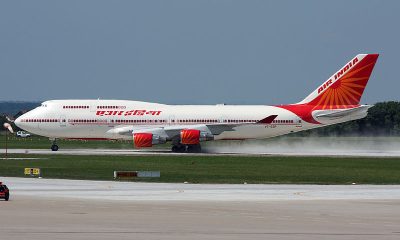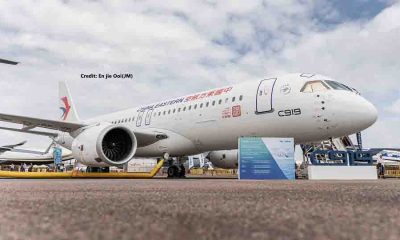Aviation
China’s Indigenous HH-100 UAS Successfully Completes First Flight

In a significant milestone for China’s aviation industry, the HH-100 aerial commercial unmanned transportation system successfully completed its maiden flight, as announced by the Aviation Industry Corporation of China (AVIC) on Wednesday.
The HH-100 demonstrator took to the skies for its inaugural flight at a general aviation airport in Xi’an, located in northwest China’s Shaanxi Province. This successful test was conducted by AVIC, China’s leading aircraft manufacturer, marking a pivotal step in the development of the country’s unmanned aerial vehicle (UAV) capabilities.
Developed independently by AVIC XAC Commercial Aircraft Co., Ltd., a subsidiary of AVIC based in Xi’an, the HH-100 consists of two main components: an unmanned aerial vehicle and a ground-based command-and-control station. This innovative system is designed to offer a cost-effective, high-payload solution for various transportation and logistical needs.
The HH-100 is notable for its low cost and large tonnage capabilities. With a designed maximum take-off weight of 2,000 kilograms and a payload capacity of 700 kilograms, it can transport approximately 4 cubic meters of cargo over a range of 520 kilometers. The drone’s maximum cruise speed is 300 kilometers per hour, and it can operate at altitudes up to 5,000 meters.
Primarily intended for feeder logistics, the HH-100 is also equipped to participate in a variety of other roles, including forest and grassland firefighting, fire monitoring, transportation and delivery of rescue materials, relay communication, and artificial rain enhancement. This versatility makes it a valuable asset in both commercial and emergency response operations.
Looking ahead, AVIC plans to develop a series of products based on the HH-100 platform, with models capable of carrying 5 tons, 10 tons, and even larger payloads. These future developments aim to meet the growing demand for large-scale, intelligent, low-cost, and highly reliable unmanned cargo planes.
The HH-100’s successful first flight marks an important achievement for AVIC and China’s aviation sector, showcasing the potential of homegrown technology to advance the country’s capabilities in unmanned aerial transportation. With its impressive range of features and applications, the HH-100 is poised to play a significant role in enhancing air-ground transportation connectivity and addressing various logistical challenges in the region.

Aviation
Boeing’s New Engineering Hub in Daytona Beach: 200 High-Paying Jobs on Offer

Boeing is set to establish a new engineering facility at Embry-Riddle Aeronautical University’s Cici & Hyatt Brown Center for Aerospace Technology in Daytona Beach, Florida.
Plans to hire 200 engineers initially
The facility will initially focus on engineering work for military aircraft programs and advanced technology capabilities. Boeing plans to hire approximately 200 high-paying engineering professionals this year, with expectations to nearly double that number in the coming years.
The work will span Boeing’s defense and government services portfolios, emphasizing engineering design, research, development, and prototyping.
Mori Hosseini, chairman of Embry-Riddle’s Board of Trustees, described the development as a significant milestone for Daytona Beach, Florida, and the broader aviation community. The facility’s construction, including a 65,000-square-foot space with a 40,000-square-foot hangar, commenced in 2022 and is on track for completion in fall.
Boeing anticipates operations to commence by late fall, contributing to the local economy and fostering collaboration with students in aerospace, cybersecurity, commercial space, and other STEM fields at Embry-Riddle’s Research Park.
Boeing investing $100,000 in Volusia County
Boeing is also demonstrating its commitment to the community with a $100,000 investment in Volusia County nonprofit organizations. This funding supports initiatives like the Second Harvest Food Bank of Volusia County Schools Partnership Program, aimed at ensuring students have access to nutritious food.
Additional support will benefit local veterans and environmental programs, underscoring Boeing’s broader impact beyond its operational footprint.
Aviation
B737 MAX 8 Cabin System Malfunctions: Passengers Experience Nosebleeds and Ear Pain

A Boeing 737 MAX 8 jet operated by Korean Air, bound for Taichung, Taiwan, encountered a distressing incident when its cabin pressurization system malfunctioned shortly after takeoff.
Reports from passengers described a sudden onset of problems, prompting the aircraft to promptly return to Incheon International Airport in Seoul, South Korea. As the malfunction unfolded, the aircraft was compelled to rapidly descend from its cruising altitude of over 30,000 feet to approximately 9,000 feet.
2 passengers suffered nosebleeds; 15 reported ear pain
This sudden change in altitude caused discomfort among passengers, with at least two individuals suffering from nosebleeds and 15 others experiencing ear pain and hyperventilation. Emergency protocols were swiftly activated, including the deployment of oxygen masks as the aircraft descended.
Passengers recounted harrowing moments during the incident, describing how the aircraft unexpectedly lowered altitude during meal service, leading to cries from children and widespread discomfort among travelers. Many reported sensations of ear pain, dizziness, and the disorienting effects of sudden cabin pressure changes.
Despite the chaotic situation, the cabin crew was commended for their prompt response, assisting passengers with oxygen masks and swiftly securing the cabin for landing. The pilots successfully landed the aircraft back at Incheon International Airport, ensuring the safety of all on board by 7:38 p.m. local time.
No serious injuries reported despite the alarming incident
Following the incident, Korean Air took immediate steps to mitigate disruption, arranging for a different aircraft to complete the flight to Taichung the following morning. The airline issued an apology to affected passengers and initiated an investigation into the root cause of the malfunction.
Videos shared by Taiwanese passengers captured the tense atmosphere inside the cabin during the incident, highlighting the urgency and gravity of the situation faced by those on board.
-
Aviation2 months ago
Israel vs Iran Military Power Comparison: Which country is stronger?
-
Airlines2 months ago
Air India’s last VVIP Boeing 747 now found a new home in USA
-
Airlines2 months ago
These are two airlines that placed the largest orders for Comac
-
Aviation2 months ago
Emirates is hiring pilots with higher salaries across 18 countries
-
Airlines2 months ago
Cathay Pacific asks business class customers to bring their own cutlery
-
Aerospace1 month ago
IndiGo to Order 100 Small Planes from Airbus, ATR, or Embraer
-
Aircraft comparison2 months ago
Osprey is faster than Chinook helicopter ?
-
Aviation2 months ago
Airbus is set to increase the production rate for the A350 as demand surges
























You must be logged in to post a comment Login